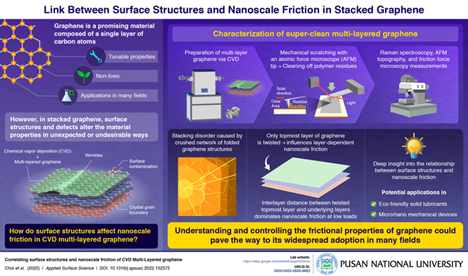Another Look at Friction in Multi-layered Graphene
Graphene use in carbon-based 2D nanomaterials is ideal for next-generation electronics, optics, catalysis, biomedicine, and more. Recently, the focus was on chemical vapor deposition (CVD) as an inexpensive way to produce larger graphene surfaces vs. mechanical exfoliation, which creates small graphene islands.
CVD graphene, however, is not challenge-free. It has surface structures and defects, including wrinkles, crystal grain boundaries, and surface contamination. It is thin, and even minor surface irregularities affect its properties.
Researchers from Pusan National University, Korea, led by Assistant Professor Songkil Kim, tackled the problem. The team first used the atom-sized tip of an atomic force microscope (AFM) to scratch the surface of CVD multi-layer graphene; they found that only the top-most layer of graphene was compromised. According to the team, further research is necessary to harness the powers of graphene.

